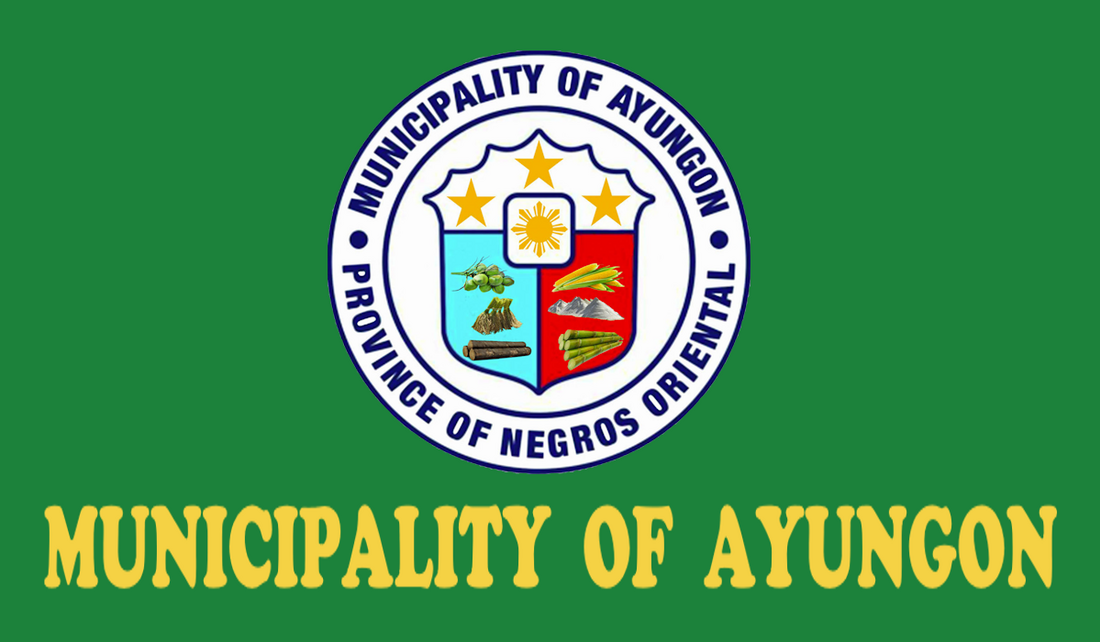Top Qs
Timeline
Chat
Perspective
Ayungon
Municipality in Negros Oriental, Philippines From Wikipedia, the free encyclopedia
Remove ads
Ayungon (Cebuano: Lungsod sa Ayungon; Tagalog: Bayan ng Ayungon), officially the Municipality of Ayungon, is a municipality in the province of Negros Oriental, Philippines. According to the 2020 census, it has a population of 47,102 people.[3]
Remove ads
Attractions include the Karalaon Bird Sanctuary, the subterranean area of the Mabato Caves, a man-made lake in Banban, and the Pagsalsalan Twin Falls (Maaslum Falls).[5]
Remove ads
History
Summarize
Perspective
There are at least two variations of the name's origin. According to Dr. Tomoteo S. Oracion of Silliman University, during the pre-colonial periods, a certain locality is named after the most popular person living in it. The most popular person happened to be a fisherman named "Ayung", who has his own hut where travellers would stop by. It was referred to as "Ayung's Place," which was later suffixed with "-on" to form "Ayungon". Another variation revolves around the Spaniards asking a native, who was cutting a tree, about the name of the place. The native thought they were asking for his name, so he answered "Ayung". The Spaniards asked the same question again, but this time, the native thought they were asking the name of tree he was cutting, so he answered "Dungon". The Spaniards coined the term "Ayung-Dungon" to refer to this area, which was later shortened to "Ayungon".[6]
During the Spanish regime, the original town plaza was located at the beach, which was transferred further inland due to a massive flood. The town also suffered an epidemic of smallpox which took away two-thirds of the town's population. Old municipal profiles refer to Ayungon as Todos los Santos, though there are no legends to explain that Hispanic name, just as there are no tales elaborating on the ruins of apparently Hispanic fortifications on the Tampocon II shoreline, perhaps because Ayungon's colonial past was not entirely its own. For many years, it was a mere barrio of Tayasan, until 1924 when Governor General Leonard Wood came to establish Ayungon as a full-fledged municipality through the recommendation of the then-provincial governor, Enrique Villanueva.
During World War II, numerous houses were burned, as well as people being tortured and killed. Many of them passed away due to famine and malaria. Maximo Romano Enardecido, the mayor at the time, evacuated the municipal government to Pangi, a mountainous village located south of the Poblacion. Captain Eugenio “Kusgan” Antonio led the town's guerilla movement. The town was liberated in October 1944, and the Americans came in to rehabilitate the town by lending money to pay for war damages.[6]
Remove ads
Geography
Summarize
Perspective
82 kilometres (51 mi) from the provincial capital Dumaguete, Ayungon is located on the midriff of Oriental Negros’ northern stretch, nearly two hours from Dumaguete.[5]
Of only three virgin forests said to be still remaining on Negros Island, one is located in barangay Banban.[5]
Barangays

Ayungon is politically subdivided into 24 barangays. Each barangay consists of puroks and some have sitios.
Climate
Remove ads
Demographics
Economy
Poverty incidence of Ayungon
10
20
30
40
50
60
70
2000
64.64 2003
60.66 2006
49.70 2009
51.59 2012
51.33 2015
52.41 2018
30.50 2021
38.42 Source: Philippine Statistics Authority[12][13][14][15][16][17][18][19] |
Ayungon is mostly rural with vast rice fields, dense coconut groves and expansive plantations of sugar cane, bananas and pineapple.[5]
As of May 2025, the once quiet town is starting to commercialize by bringing in numerous known international and national businesses in its Poblacion. Businesses like Mr. DIY, Crispy King, and Arnok's Fried Chicken started to show up in town during Dennis Amancio's mayoral term. 7-Eleven is soon to open at the Callao-Nacional Business Arcade, alongside with Mr. DIY as the first business to start operating at the arcade.
As the town is growing economically, it has been conferred with the status of 1st class income municipality.[20]
Remove ads
Education
Summarize
Perspective
The public schools in the town of Ayungon are administered by two school districts under the Schools Division of Negros Oriental.
Elementary schools:
- Amdus Elementary School — Amdus
- Anibong Elementary School — Anibong
- Awa-an Elementary School — Awa-an
- Ayungon Central Elementary School — Nat'l Highway, Poblacion
- Banban Elementary School — Banban
- Buenavista Elementary School — Atabay
- Calagcalag Elementary School — Calagcalag
- Candana-ay Elementary School — Candana-ay
- Canlukduhan Elementary School — Sitio Canlukduhan, Gomentoc
- Carol-an Elementary School — Carol-an
- Duli-Duli Elementary School — Sitio Duli-Duli, Tibyawan
- Gomentoc Elementary School — Gomentoc
- Inacban Elementary School — Inacban
- Iniban Elementary School — Iniban
- Jandalamanon Elementary School — Jandalamanon
- Kilaban Elementary School — Kilaban
- Lamigan Elementary School — Lamigan
- Libtacon Elementary School — Sitio Libtacon, Banban
- Maaslum Elementary School — Maaslum
- Mabato Elementary School — Mabato
- Manogtong Elementary School — Manogtong
- Nabalian Elementary School — Sitio Nabalian, Carol-an
- Nabhang Elementary School — Nabhang
- So-ok Elementary School — Sitio So-ok, Mabato
- South Poblacion Elementary School — Nat'l Highway, Tampocon II
- Talanyog Elementary School — Sitio Talanyog, Carol-an
- Tambo Elementary School — Tambo
- Tampocon I Elementary School — Tampocon I
- Tibyawan Elementary School — Tibyawan
- Tiguib Elementary School — Tiguib
- Tumampon Elementary School — Sitio Tumampon, Tiguib
High schools:
- Ayungon National High School — Nat'l Highway, Tampocon I
- Ayungon NHS - Carol-an Extension — Carol-an
- Ayungon Science High School — Todos Los Santos Street, Tampocon II
- Mabato Provincial Community High School — Mabato
- Tambo National High School — Tambo
Private schools:
- Negros Academy-Negros College, Inc. — Enardecido Street, Tampocon II
Remove ads
References
External links
Wikiwand - on
Seamless Wikipedia browsing. On steroids.
Remove ads




